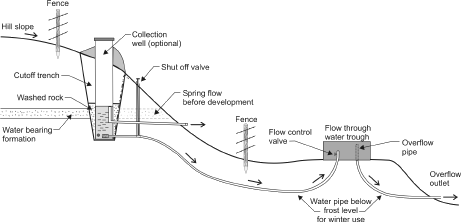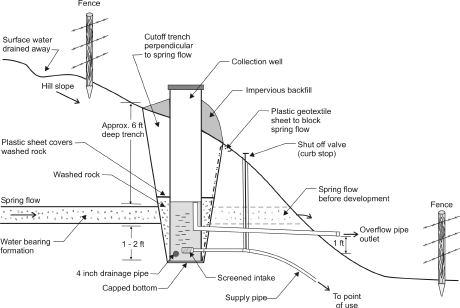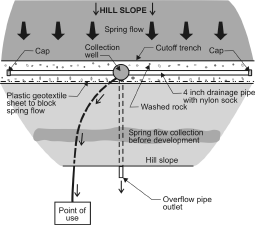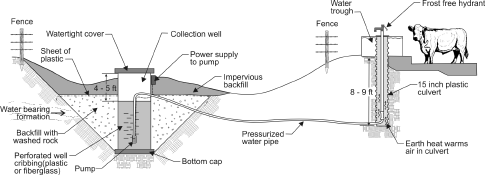| | Background | Planning | Monitoring | Development | Hillside springs | Low area springs | Design options for winter watering of livestock from spirngs | Materials | Completion
Springs have traditionally been used by allowing people and livestock direct access to the water and spring site. The result of this practice is that springs can quickly become contaminated with livestock manure and become mud holes from livestock traffic.
Proper spring development involves protecting both the spring and its water quality from environmental damage and contamination, as well as improving access to the water for all its intended uses.
Springs are less costly to develop than wells and dugouts. However, before a spring is developed, it is essential to check both the quantity and quality of the spring water because springs are highly susceptible to contamination and seasonal changes in flow rate.
Background
One of the myths pertaining to springs is they provide an enchantingly clean, cool, fresh and abundant supply of water. Although springs can sometimes provide an excellent source of good quality water, there is nothing magical about them.
A spring or seep occurs when groundwater emerges naturally on the earth's surface by either gravity or artesian pressure. Springs commonly occur along hillsides and in low areas where porous soils or fractured rock formations allow water to flow onto the ground surface. Springs can occur at a single point or over a large area, called a seep. A slow hillside seep or trickle where no visible water flow is observed should not be considered a true spring.
A spring should have water flow year-round and have at least a one-gallon per minute flow rate to be considered worthwhile for development. The springs located on hillsides often have sufficient slope to deliver water by gravity to the location where it is used. This configuration can result in significant savings, as there are no electricity or pump costs. Springs developed in low areas generally require a source of power and a pump to lift the water to its point of use.
Planning
Before you start the project, develop a long-term water management plan for the proposed spring. For this stage, you will need to look at the following:
- What water sources do you currently have?
- How much water they will provide?
- How much additional water will be required from the spring itself on a daily and annual basis?
Note: More information on calculating an annual water supply inventory and the daily and annual water requirements can be found in the Dugout Sizing Worksheets, which are part of Quality Farm Dugouts - Agdex # 716 (B01).
- What types of material and equipment are required and what are their costs?
- How do you design and construct the spring, so the water flow is effectively collected and does not result in any surface contamination or freezing in the winter?
Under the Water Act legistlation, spring development requires an approval from Alberta Environment before construction. Once the project is completed, a licence is required to divert and use the water.
Monitoring
The key to successful spring development is to ensure there is adequate water flow and water quality for the intended purpose.
- Test the flow rate of the spring to ensure the flow rate is at least one-gallon per minute or more and that the water flows year-round. The flow rate can be checked by carefully digging a five-gallon pail into the slope where the spring water is flowing and then time how long it takes to fill the pail.
- Test the water quality by taking a water sample, in a clean container, and sending it to a laboratory for a chemical water analysis.
Once the spring flow and chemical water quality are determined to be acceptable, then proceed with the spring development. If not, consider other water supply options.
Development
Several design considerations are involved when developing a spring, and their importance will largely depend on the intended water use. The design considerations are:
- Bacteriological contamination from the ground surface and/or livestock accessing the area around the spring.
- Frost penetrating and freezing the spring.
- The elevation of the spring with respect to the surrounding area and also the location to where the water is to be supplied.
- The flow rate of the spring and the amount of water required.
- Protect the resource by not taking more water from the spring than you need.

Figure 1. Hillside spring development supplying water by gravity.
Two basic types of designs are used for spring developments. One design is for low areas and the other for hillsides.
There are also several techniques used to enhance the capture of water from larger seep-type springs where the flow is spread out. The techniques include a combination of cutoff type infiltration trenches containing washed rock and perforated drainage pipe to collect the water. A layer of washed rock is placed in the trench and around the pipe. Once the water collects in the trench or pipe, it runs by gravity into a collection well or pipeline system to its point of use.
For summer livestock watering, the simplest method of spring development on hillsides is to fence off the livestock from the spring area and run the water through a pipe downslope into a watering trough as shown in Figures 1 and 2.
This system relies on gravity to supply water to livestock or for other uses. This approach reduces the risk of spring contamination and livestock being entrapped in muddy conditions around the spring. For springs in low areas, a small reservoir is dug beside or in the spring that holds from a one-day to a one-week supply of water. The reservoir is then fenced and water pumped to a trough for the livestock.

Figure 2. Hillside spring development details.
Hillside Springs
For year-round household use and livestock watering, the spring development must be protected from contamination and freezing conditions. For hillside type springs, contamination and most freezing problems can be eliminated by intercepting the spring flow below the ground surface and upslope from where it reaches the surface as shown in Figures 1 and 2.
This interception can be done with either a cutoff wall or cutoff trench to either block, or intercept the spring flow as it moves down the slope. A cutoff wall is usually made of concrete and is more difficult and costly to construct.
The cutoff trench is the preferred choice as it can be easily constructed with a backhoe by digging a trench to a depth of one to two feet lower than the spring flow and perpendicular to it, as shown in Figure 3.
The downslope wall of the trench can be lined with a heavy plastic to form a cutoff curtain that will contain water in the trench and prevent it from being lost downslope. The trench is then backfilled with a layer of washed rock to provide a porous medium to collect the spring water and allow it to flow into a collection well. If the collection well is a considerable distance away, drainage pipe can be used to reduce some of the washed rock costs and deliver water to the collection well.

Figure 3. Plan view of hillside spring development
After the washed rock and/or drainage pipe are installed, a plastic sheet should be laid on top of the washed rock before the remainder of the trench is backfilled with the excavated clay material. The plastic sheet will prevent the clay material from trickling down and either causing dirty water conditions or plugging the clean washed rock.
If sufficient elevation exists, water can be supplied by gravity through a buried pipe to its point of use. This pipe trench must be sealed off near the collection well with a sheet of plastic to prevent water from flowing along the bottom of the trench and down the hill.
Low Area Springs
For springs in low areas, the only option is to pump water to where it is needed. In these situations, the spring is dug out and a collection well installed as shown in Figure 4. The excavated area around the spring and collection well are then backfilled with a layer of washed rock so that the water can easily flow into the perforated collection well.
Again, a plastic sheet is placed over the washed rock to prevent the backfilled clay from entering and plugging the area. To prevent contamination, the area around the site is elevated with clay fill to prevent infiltration and provide surface drainage away from the spring. The area should also be fenced off to keep livestock out.

Figure 4. Low area spring development.
Table 1. Spring capacity for watering cattle.
Number of cattle
watered | Minimum spring
flow rate in gallons
per minute (gpm) | Water storage capacity
required |
 |  |  |
| 75 cow/calf | 1 gpm | 750 gallons |
| 150 cow/calf | 2 gpm | 1,500 gallons |
| 225 cow/calf | 3 gpm | 2,250 gallons |
| 300 cow/calf | 4 gpm | 3,000 gallons |
| 375 cow/calf | 5 gpm | 3,750 gallons |
| 750 cow/calf | 6 gpm | 7,500 gallons |
Note: The amount of water storage can be reduced for the given amount of cattle shown in the table if the spring flow rates are higher than those shown.
Design Options for Winter Watering of Livestock From Springs
For hillside type springs, most freezing problems can be eliminated by intercepting the spring flow below the ground surface and upslope with a cutoff wall or trench as shown in Figure 3. To do this, select an elevation six to eight feet higher up the slope to intercept the spring flow.
For springs developed in low areas, elevate the collection well and the area around it four to five feet above the water level, as shown in Figure 4, to prevent freezing.
Freezing of the water lines and watering trough can be prevented in several ways. The water pipe can be buried below the frost level, or above it, where there is sufficient water flow in the pipe to prevent freezing. At the water trough, bring the water pipe up through a 15-inch diameter plastic culvert and connect the culvert to the bottom of the trough. This culvert will provide a conduit for heat from below the ground to rise and keep the riser pipe from freezing.
Keeping the water trough smaller will reduce the amount of heat loss from the incoming water and minimize ice build-up. Insulation around the trough, a partial lid, or adding a propane or electrical heater will also solve freezing problems.
Materials
The water pipe, the collection well, plastic sheeting and other materials that are in contact with water must be rated for drinking water use. The collection well should be made of corrosion resistant materials such as plastic or fiberglass, but corrugated galvanized metal pipe is most common.
The size of the collection well should be at least 24 inches in diameter. Additional water storage such as a cistern or large stock tanks are usually required to keep up to the peak water demands of the farm and prevent de-watering or over-pumping of the spring.
The piping system should be sized to match the flow of the spring and the delivery rate required by the farm water system. Washed rock should be free of iron and other substances that can deteriorate water quality. Use drainage pipe that has a nylon filter sock to keep out sediment. For plastic sheeting, use a woven geotextile material that is stronger and will not tear during backfilling of the trench.
Completion
Once the whole spring development is completed, the entire collection well and piping system should be shock chlorinated using a similar procedure for a bored well. See Agdex 716 (D12) - Shock Chlorination and Control of Iron Bacteria.
This treatment should kill most of the bacteria that may have entered the excavation and piping during the construction. A bacteriological test should then be done on the water to ensure it is safe for household and livestock use.
For more information
Additional information is available through agricultural water specialists or on the Alberta Agriculture and Forestry website.
Agricultural Water Specialists can be contacted through the Alberta Ag-Info Centre at 310- FARM (3276).
Prepared by
Farm Water Supply Branch
Alberta Agriculture and Rural Development
Source: Agdex 716 (A15). June 2002. |
|